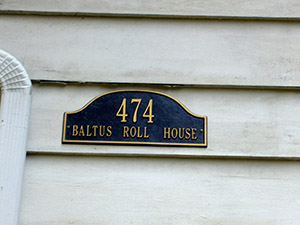Little Known Face:
Baltusrol Golf Club, Springfield, NJ, was named in honor of a murdered Dutch Farmer. It is the only major championship venue to be named after someone who was murdered. “Boltus Roll” at age 62 was attacked, tortured and killed by strangers on the night of February 22nd, 1831. His gravestone is located four miles away from the golf course in Westfield, N.J.
WESTFIELD, N.J. — On a bright, smoldering afternoon late last week, the golf historians Bob Trebus and Rick Wolffe parked their sport utility vehicle alongside Mountain Avenue and walked through a rusted iron fence into a small cemetery behind a white-steepled church.
“Do you remember where it is?” Wolffe asked.
Trebus squinted. He scanned the field for a moment before pointing about a hundred yards out, beyond a stand of pine trees, toward a sunny plot of faded gray tombstones arrayed in a row.
 Among them, sitting up straight and dignified, one red basalt headstone somehow appeared to be in better condition than the rest.
Among them, sitting up straight and dignified, one red basalt headstone somehow appeared to be in better condition than the rest.
“In memory,” it read, “of Boltus Roll.”
When the 98th P.G.A. Championship begins Thursday at nearby Baltusrol Golf Club, fans might wonder about the club’s name. Some might know the ridge poking up from behind the fifth green as Baltusrol Mountain. Others might know the leafy street in Summit above Interstate 78 as Baltusrol Road.
What sometimes gets lost to history is that the road, the mountain, and the world-famous golf course are linked by the memory of a farmer and the macabre legend of his coldblooded murder on a wintry night in 1831.
Wolffe and Trebus are among a group of Baltusrol historians who have done their best to keep the membership aware of the farmer’s tragic connection to what became his eponymous club. About 25 years ago, one of their colleagues, Dick Brown, discovered a plaque on the side of a home atop the ridge near the Watchung Reservation, with views that gaze east across the hallowed 36-hole golf club and Union County.
The plaque said it was Baltus Roll’s house. That must have been the site, the historians surmised, where the old farmer was killed. (It is widely believed that, in the hasty arrangements after Roll’s death, the tombstone carver misheard the spelling and mistakenly put an “o” in his first name.
Almost two centuries later, this sad, gruesome slice of New Jersey’s early history still echoes in club lore and ghost tales. Not long ago, Wolffe uncovered writings by A. W. Tillinghast, the course’s renowned architect, which mentioned observances of strange, devilish creatures stalking the woods of the ridge at night.
Members occasionally bring up Roll’s legend in a different light.
“I’ve often heard people say that the rough is so thick, it’s Baltus Roll getting his revenge,” Trebus said.
In life, Baltus Roll resided with his wife, Susannah, and son on what was then a far less populated ridge, where they grew apples and raised livestock.
At around midnight on the rainy night of Feb. 22, 1831, Roll, then 62, and his wife were woken by a loud pounding on the door. A man called out that he was looking for directions to some indecipherable place. Then the voice quickly followed up by asking, “Are you not going to get up?”
When Roll answered no, the door burst open. Two men rushed in, grabbed Roll from his bed, beat him and dragged him outside into the cold.
According to his widow’s testimony in a Newark courtroom in June 1831, she saw the two men tying up her husband in the yard with a thick white rope.

Read more Zack Schonbrun at NewYorkTimes.com



